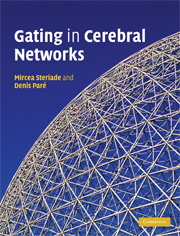Book contents
- Frontmatter
- Contents
- Preface
- Acknowledgements
- Chapter 1 Morphology and electroresponsive properties of thalamic neurons
- Chapter 2 Morphology and electroresponsive properties of neocortical cells
- Chapter 3 The amygdala
- Chapter 4 Rhinal and medial prefrontal cortices
- Chapter 5 Neuromodulation and state-dependent activities in forebrain neuronal circuits
- Chapter 6 Gating of signals in slow-wave sleep
- Chapter 7 Neuronal processes and cognitive functions in brain-active states of waking and REM sleep
- Chapter 8 Comparison of state-dependent activity patterns in the thalamocortical, hippocampal and amygdalocortical systems
- Chapter 9 Neuronal substrates of some mental disorders
- References
- Index
- Plate section
Chapter 7 - Neuronal processes and cognitive functions in brain-active states of waking and REM sleep
Published online by Cambridge University Press: 18 August 2009
- Frontmatter
- Contents
- Preface
- Acknowledgements
- Chapter 1 Morphology and electroresponsive properties of thalamic neurons
- Chapter 2 Morphology and electroresponsive properties of neocortical cells
- Chapter 3 The amygdala
- Chapter 4 Rhinal and medial prefrontal cortices
- Chapter 5 Neuromodulation and state-dependent activities in forebrain neuronal circuits
- Chapter 6 Gating of signals in slow-wave sleep
- Chapter 7 Neuronal processes and cognitive functions in brain-active states of waking and REM sleep
- Chapter 8 Comparison of state-dependent activity patterns in the thalamocortical, hippocampal and amygdalocortical systems
- Chapter 9 Neuronal substrates of some mental disorders
- References
- Index
- Plate section
Summary
We now discuss the neuronal processes that account for the increased responsiveness of brainstem, thalamic and cortical neurons during wakefulness and REM sleep. The closing of thalamic gates during slow-wave sleep (see Chapter 6) is modified upon transition to both brain-active states under the influence of increased neuronal activities in ascending activating modulatory (mainly glutamatergic and cholinergic) systems. In addition, the different types of low-frequency rhythms that occur during slow-wave sleep in the disconnected brain are transformed into faster (beta and gamma) oscillations, which are thought to play a significant role in sustaining the mental activity that characterizes brain-active states.
Similarities and basic differences between waking and REM sleep
Global electrical signs differentiating waking from REM sleep
The global signs that characterize the two brain-active states are EEG rhythms, muscular tone, and eye movements associated with sharp waves in brainstem–thalamocortical systems. The tonic EEG activation associated with fast rhythms (usually 20–60 Hz) in waking is virtually identical to that in REM sleep, and distinguishes both of these states from the low-frequency (less than 15 Hz) oscillations that prevail during slow-wave sleep. The other tonic aspect, muscular atonia, specifically distinguishes REM sleep from the other two major states of vigilance (Jouvet & Michel, 1959) and is taken as the cardinal sign of REM sleep. Finally, phasic eye movements are voluntary during waking and occur as involuntary ocular saccades in REM sleep, when they are accompanied by spiky ponto-geniculo-occipital (PGO) potentials in brainstem and thalamocortical systems.
- Type
- Chapter
- Information
- Gating in Cerebral Networks , pp. 181 - 217Publisher: Cambridge University PressPrint publication year: 2007

